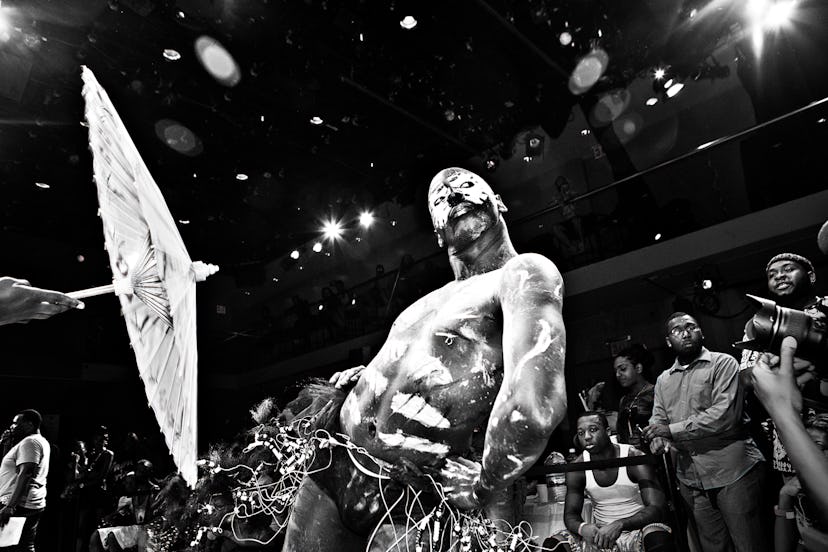What the Kiki Ballroom Scene Looks Like Now: A Family Photo Album

Ryan Murphy’s latest project Pose is a flashy and vigorous take on the 1980s ballroom scene, featuring the largest trans cast on television. This is Murphy, so there is plenty of dramatization, but in its nevertheless historically accurate retelling of 1987 New York the show is doing something that has yet to be done on a major cable network: preserving the ballroom scene decades after its rise. There are more straightforward documentations of the culture bubbling to the surface now, too: Viceland has its new docu-series My House, and, with the support of the IWMF (International Women in Media Fund), the photographer Anja Matthes has captured the contemporary ball scene in her forthcoming publication, The Kiki Yearbook, a “coming of age milestone” that celebrates the lives of queer and transgender people of color as they carve out their niche in the Kiki subset of ball culture. In the various ballroom Houses of New York, teens and young adults—many of whom are members of the LGBTQ community who have been abandoned by their families—join Houses, which provide community, safety, and guidance, and compete for trophies in walking and voguing competitions. Ballroom culture can be traced back to Harlem in the ’20s, where drag balls explored both racial taboos and gender nonconformity, and the House system’s roots can traced to the late 1980s, where Houses emerged as a call to action for HIV/AIDS and STD prevention. The Kiki scene was born in 2003, as a collaboration between members of the larger ballroom scene and HIV and STD prevention workers—many of whom are also House members—and still flourishes today. Before Pose, there was of course Jennie Livingston’s famous 1990 documentary Paris Is Burning, and the ballroom scene has influenced and been ripped off by pop culture in countless ways—Madonna’s “Vogue” video is an oft-cited example—but rarely do the young black and Latino members of the scene get proper representation or acknowledgement in mainstream media. With The Kiki Yearbook, Matthes celebrates and illuminates those lives and families. Meet them here.
1
Zay Lanvin performing in the Vogue Femme category at the Latex Ball. Photograph by Anja Matthes.
2
Twiggy Pucci Garcon, overall overseer of the House of Garcon and Pose consultant. Many marginalized and at-risk groups like LGBTQ youth, can gain self-acceptance and confidence through the surrogate families formed in the Kiki community, and Twiggy Pucci Garcon has organized and advocated for LGBTQ youth with various collaborative organizations to create safe spaces for over nine years. Photograph by Anja Matthes.
3
Christine Rachel Ebony performing in the “Butch Queen Vogue Femme” category at The Legends Ball. (Christine has transitioned since this performance at The Legends Ball.) Photograph by Anja Matthes.
4
Members of the House of Bangy Cunts after their practice in East New York. Photograph by Anja Matthes.
5
Legendary Mother Afrika Juicy performing in the “Runway” category as a house at the Old Navy Ball. Kiki balls are a celebratory component of the Kiki subculture, offering a safe and empowered space for performers to enact various genres of gender expression, including stylized femininity. Photograph by Anja Matthes.
6
Aniyah celebrates her 21st birthday with her family Nash, Starasia, Jocelyn, Diamond, and Denim. The familial structure of Kiki houses—mother, father, sister, brother—often acts as a surrogate for a biological family. Photograph by Anja Matthes.
7
A mysterious performer at Live a Metallic Life, METALIKA Ball. Photograph by Anja Matthes.
8
Eyricka and members of the Iconic International House of Mizrahi at the Latex Ball. Photograph by Anja Matthes.
9
NYC Mother Iggy Unbothered-Cartier and Omari Gabbana performing at Live a Metallic Life, METALIKA Ball. Photograph by Anja Matthes.
10
Legendary DaeDae, father of the House of Bangy Cunts, with his brother Dutch Gotti. DaeDae is photographer Anja Matthes’ godson. He passed away last year. Photograph by Anja Matthes.
11
The House of La Familia Margiela. Left to right: overall mother Candice, founding mother Diamond, overall NYC mother Natalie, and Tyler. The Kiki Yearbook symbolizes a coming-of-age milestone for many youths in the Kiki scene who have been abandoned by their parents, and often were not able to finish high school. This project was made possible with the support of IWMF (International Women in Media Fund). Photograph by Anja Matthes.